Palaeoenvironment, Settlement, and Land Use in the Late Neolithic—Bronze Age Site of Colombare di Negrar di Valpolicella (N Italy, On-Site)
Abstract
:1. Introduction
2. Materials and Methods
2.1. Study Area and Archaeological Context
2.2. Stratigraphy and Chronology
2.2.1. Trench 4 (Excavated in 2019–2021)
2.2.2. Trench 5 (Excavated in 2020)
2.3. Archaeobotanical Analyses: Pollen and Macroremains
2.3.1. Palynology
2.3.2. Seeds and Fruits
3. Results
3.1. Palynology
- -
- A total of three grains has large reticulum and diameter 43–47 μm, as T. platyphyllos type;
- -
- A total of nine grains has four apertures and a diameter < 40 μm;
- -
- A total of 24 grains has a fine reticulum: 5 are 35–36 μm as T. cordata type, and 19 are 43–47 μm. Therefore, pollen morphology suggests that the lime trees belonged to two species that hybridize between them.
- -
- The bottom zone (samples no. 9 to 6; SU 17,14,9,8) is characterised by the presence of Pinus, Acer, Humulus lupulus, and Syringa among the woody plants, while Daucus, Potentilla, Anagallis, Cyclamen, and Lamiaceae are more evident than in the other zone;
- -
- The top zone (samples no. 5 to 1; SU 7,6,5,4,1) shows the main changes in the increase in values of Ostrya carpinifolia/Carpinus orientalis type, Fraxinus excelsior type, and Tilia cordata/platyphyllos; the latter marks a significant rise in wet conditions as confirmed by the appearance of Alnus and Populus trees, besides Typha/Sparganium among the herbaceous plants. Accordingly, the Cichorieae tribe has a slight decrease.
3.2. Seeds and Fruits
4. Discussion
4.1. Tilia Species and Hybrids in the Wood
4.2. Hazelnut, Grapevine, and the Other Traits of the Landscape
4.3. Wet Environments
4.4. Cereals and Pasturelands
4.5. Environmental Conditions at the Establishment of the Site
4.6. Environmental Transformations during the Site Occupation
5. Conclusions
Author Contributions
Funding
Institutional Review Board Statement
Informed Consent Statement
Data Availability Statement
Acknowledgments
Conflicts of Interest
References
- Tecchiati, U.; Salzani, P.; Orioli, M.; Mercuri, A.M.; Talamo, S.; Nicosia, C.; Amato, A.; Casati, S.; Cercatillo, S.; Florenzano, A.; et al. Agricoltura e gestione del territorio nell’età del Rame dei Lessini occidentali: Lavori in corso nel sito di Colombare di Villa (Negrar di Valpolicella, VR). IpoTESI di Preistoria 2021, 14, 59–74. [Google Scholar] [CrossRef]
- Tecchiati, U.; Castiglioni, E.; Rottoli, M. Economia di sussistenza nell’età del Rame dell’Italia settentrionale. Il contributo di archeozoologia e archeobotanica. In L’età del Rame: La Pianura Padana e le Alpi al Tempo di Ötzi; de Marinis, R.C., Ed.; La Compagnia Della Stampa Massetti Rodella: Brescia, Italy, 2013; pp. 39–52. [Google Scholar]
- Riedel, A. La fauna del villaggio eneolitico delle Colombare di Negrar (Verona). Bollettino del Museo Civico di Storia Naturale di Verona 1976, 3, 205–238. [Google Scholar]
- Zorzi, F. Resti di un abitato capannicolo eneolitico alle Colombare di Negrar (Verona). In Actes du IV Congrès International du Quaternaire (Rome-Pise, août-septembre 1953); Blanc, G.A., Ed.; Istituto Italiano di Paleontologia Umana: Roma, Italy, 1956; pp. 3–15. [Google Scholar]
- Zorzi, F. Insediamenti e stirpi. Capitolo II: Le culture oloceniche in Preistoria Veronese. In Verona e il Suo Territorio; Cavallari, V., Gazzola, P., Scolari, A., Eds.; Istituto per gli Studi Storici Veronesi: Valdonega, Italy, 1960; Volume 1, pp. 98–114. [Google Scholar]
- Tecchiati, U.; Salzani, P.; Orioli, M.; Mercuri, A.M.; Talamo, S.; Amato, A.; Casati, S.; Florenzano, A.; Palmisano, E.; Proserpio, B.; et al. Indagini archeologiche e paleoambientali nel sito neolitico e dell’età del Rame delle Colombare di Villa (Comune di Negrar di Valpolicella, VR). In Abstract Book della Riunione Scientifica dell’Istituto Italiano di Preistoria e Protostoria (Ferrara, 20–23 ottobre 2021); Arzarello, M., Fontana, F., Peresani, M., Thun Hohenstein, U., Eds.; Istituto Italiano di Preistoria e Protostoria: Firenze, Italy, 2021; pp. 5–6. [Google Scholar]
- Pearsall, D.M. Palaeoethnobotany: A Handbook of Procedures, 2nd ed.; Academic Press: San Diego, CA, USA, 2000. [Google Scholar]
- Faegri, K.; Kaland, P.E.; Krzywinski, K. Textbook of Pollen Analysis, 4th ed.; John Wiley and Sons: Chichester, UK, 1989. [Google Scholar]
- Mercuri, A.M. Genesis and evolution of the cultural landscape in central Mediterranean: The ‘where, when and how’ through the palynological approach. Landsc. Ecol. 2014, 29, 1799–1810. [Google Scholar] [CrossRef]
- Behre, K.E. Anthropogenic Indicators in Pollen Diagrams; A.A.Balkema: Rotterdam, The Netherlands, 1986. [Google Scholar]
- Mercuri, A.M.; Bandini Mazzanti, M.; Florenzano, A.; Montecchi, M.C.; Rattighieri, E.; Torri, P. Anthropogenic Pollen Indicators (API) from archaeological sites as local evidence of human-induced environments in the Italian peninsula. Ann. Bot. 2013, 3, 143–153. [Google Scholar] [CrossRef]
- Mercuri, A.M.; Florenzano, A.; Burjachs, F.; Giardini, M.; Kouli, K.; Masi, A.; Picornell-Gelabert, L.; Revelles, J.; Sadori, L.; Servera-Vives, G.; et al. From influence to impact: The multifunctional land-use in Mediterranean prehistory emerging from palynology of archaeological sites (8.0–2.8 ka BP). Holocene 2019, 29, 830–846. [Google Scholar] [CrossRef] [Green Version]
- Tecchiati, U.; Putzolu, C. Un approccio globale al concetto di sistema territoriale: Alcune riflessioni di metodo. In Tiziano Mannoni: Attualità e Sviluppi di Metodi e Idee; ISCUM, Ed.; All’Insegna del Giglio: Firenze, Italy, 2021; Volume 2, pp. 521–523. [Google Scholar]
- Florenzano, A.; Mercuri, A.M.; Pederzoli, A.; Torri, P.; Bosi, G.; Olmi, L.; Rinaldi, R.; Bandini Mazzanti, M. The significance of intestinal parasite remains in pollen samples from Mediaeval pits in the Piazza Garibaldi of Parma, Emilia-Romagna, Northern Italy. Geoarchaeology 2012, 27, 34–47. [Google Scholar] [CrossRef]
- van der Kaars, S.; Penny, D.; Tibby, J.; Fluin, J.; Dam, R.; Suparan, P. Late Quaternary palaeoecology, palynology and palaeolimnology of a tropical lowland swamp: Rawa Danau, West Java, Indonesia. Palaeogeogr. Palaeoclimatol. Palaeoecol. 2001, 171, 185–212. [Google Scholar] [CrossRef]
- Moore, P.D.; Webb, J.A.; Collins, M.E. Pollen Analysis, 2nd ed.; Blackwell Sc. Publ.: Oxford, UK, 1991. [Google Scholar]
- Reille, M. Pollen et Spores d’Europe et d’Afrique du Nord; Laboratoire de Botanique Historique et Palinologie: Marseille, France, 1992. [Google Scholar]
- Andersen, S.T. Identification of Wild Grass and Cereal Pollen; Danmarks Geologiske Undersøgelse Aarbog: Copenaghen, Denmark, 1979. [Google Scholar]
- Beug, H.-J. Leitfaden der Pollenbestimmung für Mitteleuropa und Angrenzende Gebiete, 2nd ed.; Verlag Dr. Friedrich Pfeil: München, Germany, 2015. [Google Scholar]
- Mercuri, A.M.; Bandini Mazzanti, M.; Florenzano, A.; Montecchi, M.C.; Rattighieri, E. Olea, Juglans and Castanea: The OJC group as pollen evidence of the development of human-induced environments in the Italian peninsula. Quat. Int. 2013, 303, 24–42. [Google Scholar] [CrossRef]
- Grimm, E.C. Tilia and TGView; Illinois State Museum: Springfield, IL, USA, 2004. [Google Scholar]
- Berggren, G. Atlas of Seeds and Small Fruits of Nortwest-European Plant Species (Sweden, Norway, Denmark, East Fennoscandia and Iceland) with Morphological Descriptions: Part 2—Cyperaceae; Swedish Museum of Natural History: Stockholm, Sweden, 1969. [Google Scholar]
- Berggren, G. Atlas of Seeds and Small Fruits of Nortwest-European Plant Species (Sweden, Norway, Denmark, East Fennoscandia and Iceland) with Morphological Descriptions: Part 3—Salicaceae and Cruciferae; Swedish Museum of Natural History: Stockholm, Sweden, 1981. [Google Scholar]
- Jacomet, S. Identification of Cereal Remains from Archaeological Sites, 2nd ed.; Basel University: Basel, Switzerland, 2006. [Google Scholar]
- Jaquat, C. Les plantes de l’âge du Bronze. Catalogue des friuts et graines. Archeologie Neucheteloise. Bulletin Mensuel de la Société Linnéenne de Lyon 1989, 58, 5. [Google Scholar]
- Knörzer, K.H.; Kalis, A.J.; Meurers-Balke, J.; Tegtmeier, U. Geschichte Der Synanthropen Flora Im Niederrheingebiet: Pflanzenfunde Aus Archäologischen Ausgrabungen; Zabern: Mainz, Germany, 2007. [Google Scholar]
- Schoch, W.H.; Pawlik, B.; Schweingruber, F.H. Botanische Makroreste: Ein Atlas Zur Bestimmung Häufig Gefundener und Ökologisch Wichtiger Pflanzensamenn; Paul Haupt: Bern-Stuttgart, Switzerland, 1988. [Google Scholar]
- Cappers, R.; Neef, R.; Bekker, R. Digital Atlas of Economic Plants in Archaeology; Barkhuis & Groningen University Library: Groeniungen, The Netherlands, 2012. [Google Scholar]
- Pignatti, S. Flora d’Italia; Edizioni Edagricole: Bologna, Italy, 1982. [Google Scholar]
- Zohary, D.; Hopf, M.; Weiss, E. Domestication of Plants in the Old World: The Origin and Spread of Domesticated Plants in Southwest Asia, Europe, and the Mediterranean Basin, 4th ed.; Oxford University Press: Oxford, UK, 2012. [Google Scholar]
- Christensen, P.B.; Blackmore, S. Tiliaceae. In The Northwest European Pollen Flora V, Review of Palaeobotany and Palynology, 57; Punt, W., Blackmore, S., Clarke, G.C.S., Eds.; Elsevier: Amsterdam, The Netherlands, 1988; pp. 33–43. [Google Scholar]
- Zappa, J.; Torri, P.; Clò, E.; Rottoli, M.; Castiglioni, E.; Bassetti, M.; Mottes, E.; Mercuri, A.M. Vegetation changes and land-use history in the ritual site of Gardolo, Copper and Bronze Age site in Trentino (N Italy). Quaternary 2022. to be submitted. [Google Scholar]
- Accorsi, C.A.; Bandini Mazzanti, M.; Mercuri, A.M.; Rivalenti, C.; Trevisan Grandi, G. Holocene Forest pollen vegetation of the Po plain—Northern Italy (Emilia Romagna data). Allionia 1996, 34, 233–276. [Google Scholar]
- Torri, P.; Fornaciari, R.; Mercuri, A.M. Inferenze paleoambientali ed etnobotaniche dalla serie pollinica ‘FG-LUGO near-site’. In Il Villaggio Neolitico di Lugo di Romagna-Fornace Gattelli: Strutture Ambiente Culture; Steffè, G., Degasperi, N., Eds.; Istituto Italiano di Preistoria e Protostoria: Firenze, Italy, 2019; pp. 179–188. [Google Scholar]
- Giesecke, T.; Brewer, S.; Fisinger, W.; Leydet, M.; Bradshaw, R.H.W. Patterns and dynamics of European vegetation change over the last 15000 years. J. Biogeogr. 2017, 44, 1441–1456. [Google Scholar] [CrossRef] [Green Version]
- Grant, M.J.; Waller, M.P.; Groves, J.A. The Tilia decline: Vegetation change in lowland Britain during the mid and late Holocene. Quat. Sci. Rev. 2011, 30, 394–408. [Google Scholar] [CrossRef]
- De Benedetti, C.; Gerasimenko, N.; Ravazzi, C.; Magri, D. History of Tilia in Europe since the Eemian: Past distribution patterns. Rev. Palaeobot. Palynol. 2022, 307, 104778. [Google Scholar] [CrossRef]
- Wrońska-Pilarek, D.; Danielewicz, W.; Bocianowski, J.; Maliński, T.; Janyszek, M. Comparative pollen morphological analysis and its systematic implications on three European Oak (Quercus L., Fagaceae) species and their spontaneous hybrids. PLoS ONE 2016, 11, e016176. [Google Scholar] [CrossRef] [PubMed] [Green Version]
- Andrew, R. Exine pattern in the pollen of British species of Tilia. New Phytol. 1971, 70, 683–686. [Google Scholar] [CrossRef]
- Bernetti, G. Le Piante del Bosco. Forme, vita e Gestione; Compagnia delle Foreste: Arezzo, Italy, 2015. [Google Scholar]
- Associazione Culturale Borgo Baver Onlus. Dossier di Candidatura di una Pratica Tradizionale: La Piantata Veneta; Associazione Culturale Borgo Baver onlus: Godega di Sant’Urbano, Italy, 2017. [Google Scholar]
- Del Favero, R.; Carraro, G.; Dissegna, M.; Giaggio, C.; Savio, D.; Zen, S.; Abramo, E.; Andrich, O.; Corona, P.; Cassol, M.; et al. Biodiversità e Indicatori nei Tipi Forestali del Veneto; Regione del Veneto-Direzione Regionale Delle Foreste e Dell’Economia Montana, Accademia Italiana di Scienze Forestali: Mestre-Venezia, Italy, 2000. [Google Scholar]
- Mercuri, A.M.; Accorsi, C.A.; Bandini Mazzanti, M.; Bosi, G.; Cardarelli, A.; Labate, D.; Marchesini, M.; Trevisan Grandi, G. Economy and environment of Bronze Age settlements—Terramare—In the Po Plain (Northern Italy): First results of the archaeobotanical research at the Terramara di Montale. Veg. Hist. Archaeobotany 2006, 16, 43–60. [Google Scholar] [CrossRef]
- Turner, S.D.; Brown, A.G. Vitis pollen dispersal in and from organic vineyards I. Pollen trap and soil pollen data. Rev. Palaeobot. Palynol. 2004, 129, 117–132. [Google Scholar] [CrossRef]
- Mercuri, A.M.; Torri, P.; Florenzano, A.; Clò, E.; Mariotti Lippi, M.; Sgarbi, E.; Bignami, C. Sharing the agrarian knowledge with archaeology: First evidence of the dimorphism of Vitis pollen from the Middle Bronze Age of N Italy (Terramara Santa Rosa di Poviglio). Sustainability 2021, 13, 2287. [Google Scholar] [CrossRef]
- Cremaschi, M.; Mercuri, A.M.; Torri, P.; Florenzano, A.; Pizzi, C.; Marchesini, M.; Zerboni, A. Climate change versus land management in the Po Plain (Northern Italy) during the Bronze Age: New insights from the VP/VG sequence of the Terramara Santa Rosa di Poviglio. Quat. Sci. Rev. 2016, 136, 153–172. [Google Scholar] [CrossRef]
- Mercuri, A.M.; Montecchi, M.C.; Pellacani, G.; Florenzano, A.; Rattighieri, E.; Cardarelli, A. Environment, human impact and the role of trees on the Po plain during the Middle and Recent Bronze Age: Pollen evidence from the local influence of the terramare of Baggiovara and Casinalbo. Rev. Palaeobot. Palynol. 2015, 218, 231–249. [Google Scholar] [CrossRef]
- Ucchesu, M.; Orrù, M.; Grillo, O.; Venora, G.; Usai, A.; Serreli, P.F.; Bacchetta, G. Earliest evidence of a primitive cultivar of Vitis vinifera L. during the Bronze Age in Sardinia (Italy). Veget. Hist. Archaeobotany 2015, 24, 587–600. [Google Scholar] [CrossRef]
- Pecci, A.; Borgna, E.; Mileto, S.; Dalla Longa, E.; Bosi, G.; Florenzano, A.; Mercuri, A.M.; Corazza, S.; Marchesini, M.; Vidale, M. Wine consumption in Bronze Age Italy: Combining organic residue analysis. J. Archaeol. Sci. 2020, 123, 105256. [Google Scholar] [CrossRef]
- Lazzaro, L.; Sarracco, E.; Benesperi, R.; Coppi, A. A probable anthropic origin of Nerium oleander L. (Apocynaceae) population in Montecristo island (Italy, Tuscany): Evidence from loci polymorphism and ISSR analysis. Caryologia 2018, 71, 50–57. [Google Scholar] [CrossRef]
- Castiglioni, E.; Rottoli, M. I resti botanici da Maserà—Via Bolzani, Monselice—Via Valli e Este—Località Meggiaro nel quadro del Neolitico medio-recente e dell’Eneolitico in Italia settentrionale. In Dinamiche Insediative nel Territorio dei Colli Euganei dal Paleolitico al Medioevo, Atti del Convegno di Studi di Archeologia e Territorio, Este-Monselice, Italy, 27–28 November 2009; Bianchin Citton, E., Rossi, S., Zavonello, P., Eds.; Beni Culturali: Firenze, Italy, 2014; pp. 86–92. [Google Scholar]
- Akeret, O. Plant remains from Bell Beker site in Switzerland and the beginnings of Triticum spelta (spelt) cultivation in Europe. Veg. Hist. Archaeobotany 2005, 14, 279–286. [Google Scholar] [CrossRef]
- Lechterbeck, J.; Kerig, T.; Kleinmann, A.; Sillimann, M.; Wick, L.; Rösch, M. How was Bell Beker economy related to Corded Ware and Early Bronze Age lifestyles? Archaeological, botanical and palynological evidence from the Hegau, Western Lake Constance region. Environ. Archaeol. 2013, 19, 95–113. [Google Scholar] [CrossRef]
- Perego, R. Contribution to the Development of the Bronze Age Plant Economy in the Surrounding of the Alps: An Archaeobotanical Case Study of Two Early and Middle Bronze Age Sites in Northern Italy (Lake Garda region). Ph.D. Thesis, University of Basel, Basel, Switzerland, 2015. [Google Scholar]
- Berto, F.; Rottoli, M. Agricoltura e raccolta in un insediamento del Bronzo recente della pianura veronese: Il pozzetto US 317 di Fondo Paviani (Verona)—Scavi Università di Padova 2007–2012. In Preistoria e Protostoria del Veneto—(Studi di preistoria e Protostoria; Leonardi, G., Tiné, V., Eds.; Istituto Italiano di Preistoria e Protostoria: Firenze, Italy, 2015; pp. 829–832. [Google Scholar]
- Rottoli, M.; Castiglioni, E. Indagini sui resti vegetali macroscopici. In Acqua e Civiltà Nelle Terramare. La Vasca Votiva di Noceto; Bernabò Brea, M., Cremaschi, M., Eds.; Skira: Milano, Italy, 2009; pp. 152–163. [Google Scholar]
- Dal Corso, M.; Zanon, M.; Heron, C.; Rottoli, M.; Cupitò, M.; Dalla Longa, E.; Kirleis, W. Tracing millet through biomarker analyses in archaeological sites in alluvial plains: The first miliacin data from the northern Italian Bronze Age. In Millet and What Else? The Wider Context of the Adoption of Millet Cultivation in Europe—Scales of Transformation in Prehistoric and Archaic Societies 14; Kirleis, W., Dal Corso, M., Filipović, D., Eds.; Sidestone Press: Leiden, Germany, 2022; pp. 231–252. [Google Scholar]
- Florenzano, A.; Clò, E.; Jacob, J. Pollen and molecular biomarkers from sedimentary archives: Complementary tools to improve knowledge on agriculture and human impact in the central Po Plain (N Italy). Sustainability 2022. to be submitted. [Google Scholar]
- Tafuri, M.A.; Craig, O.E.; Canci, A. Stable Isotope Evidence for the Consumption of Millet and Other Plants in Bronze Age Italy. Am. J. Phys. Anthropol. 2009, 139, 146–153. [Google Scholar] [CrossRef]
- Filipović, D.; Meadows, J.; Dal Corso, M.; Kirleis, W.; Alsleben, A.; Akeret, Ö.; Bittmann, F.; Bosi, G.; Ciută, B.; Dreslerová, D.; et al. New AMS 14C dates track the arrival and spread of broomcorn millet cultivation and agricultural change in prehistoric Europe. Sci. Rep. 2020, 10, 13698. [Google Scholar] [CrossRef]
- Florenzano, A. The history of pastoral activities in S Italy inferred from palynology: A long-term perspective to support biodiversity awareness. Sustainability 2019, 11, 404. [Google Scholar] [CrossRef]

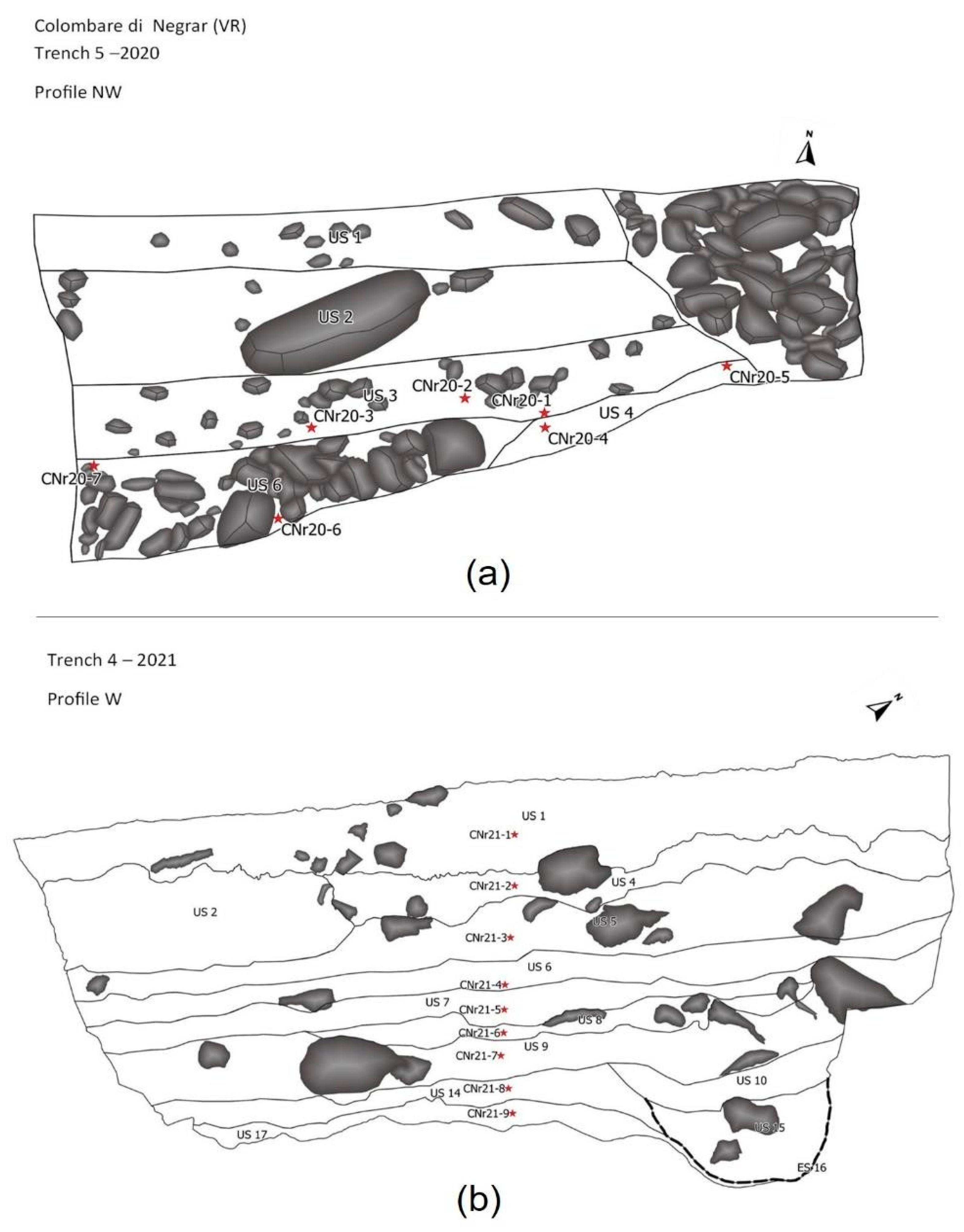
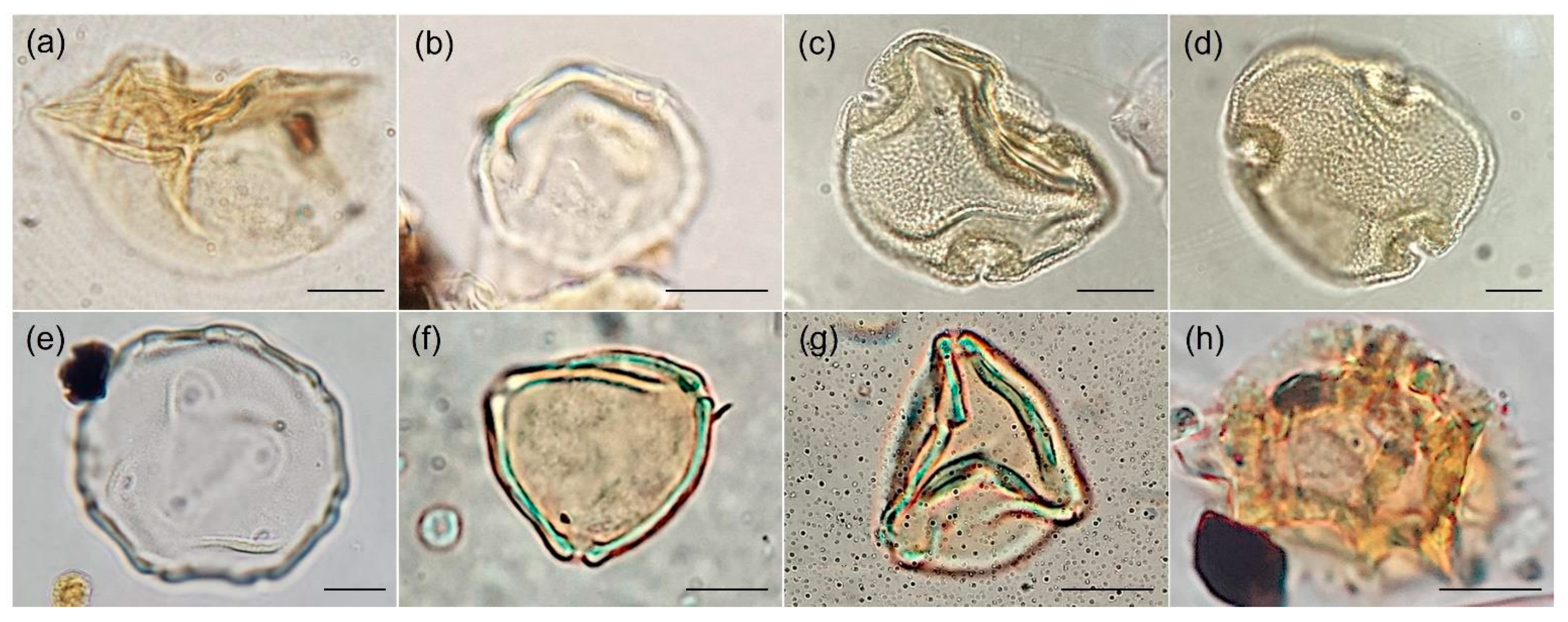
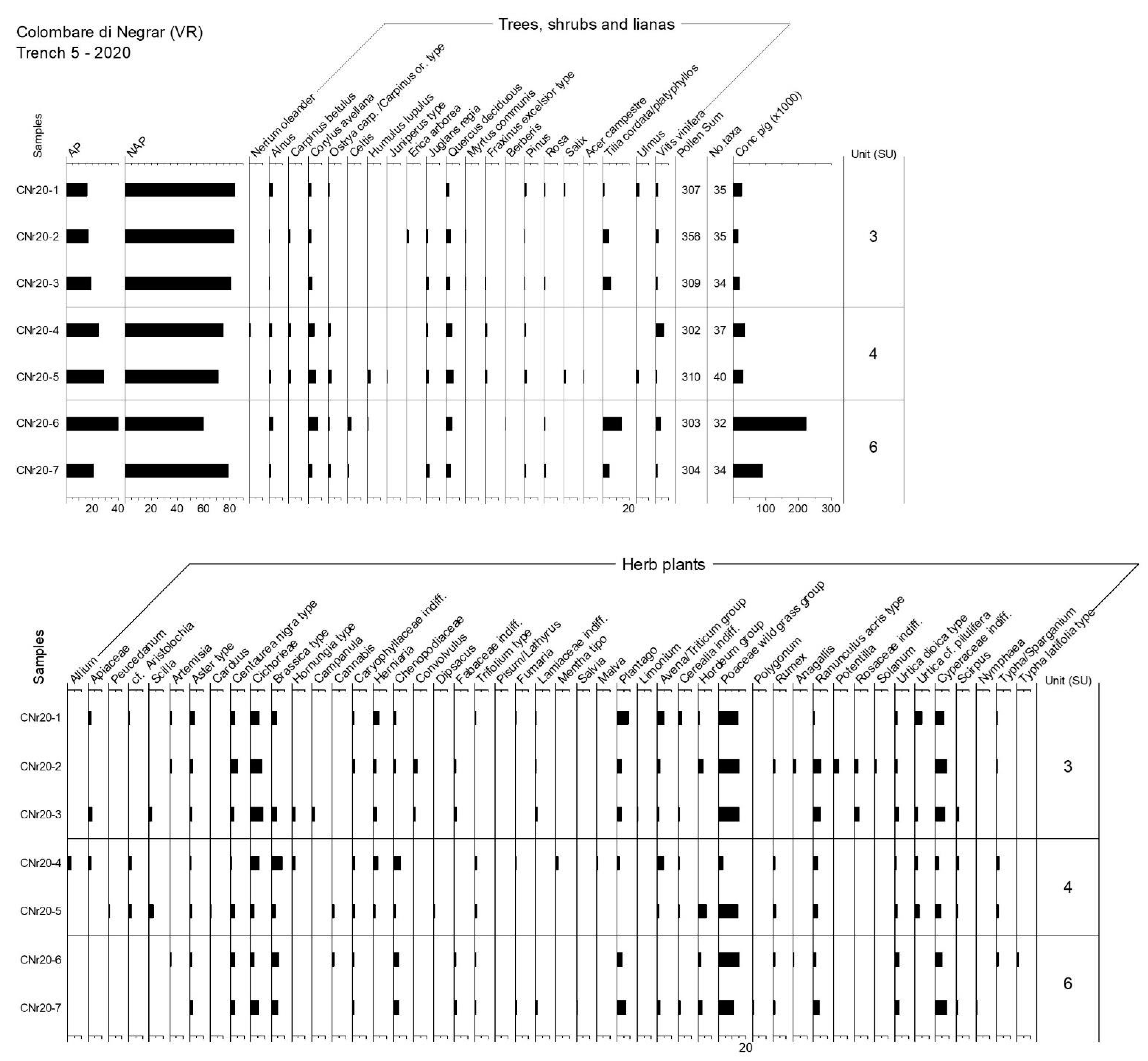
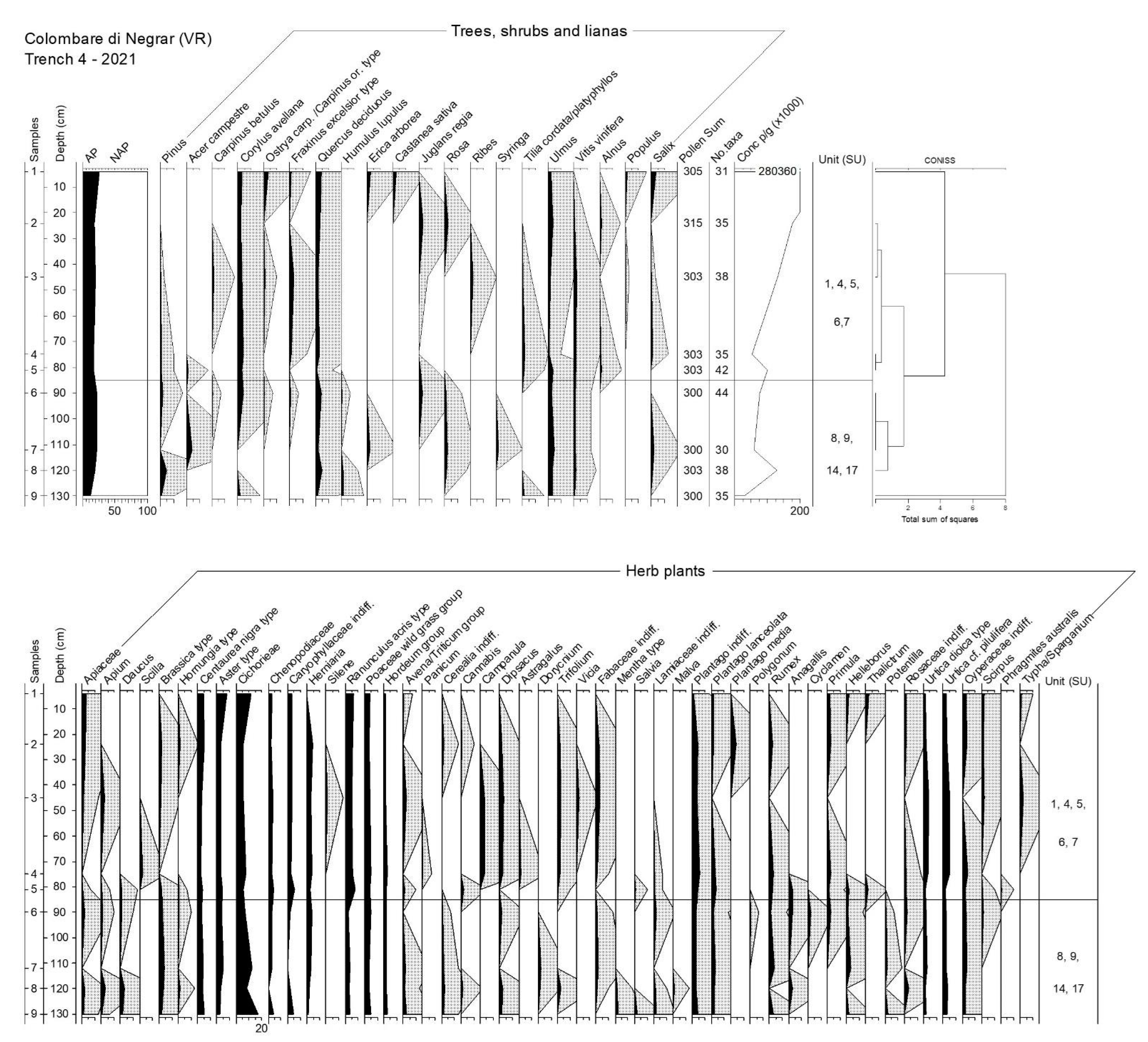
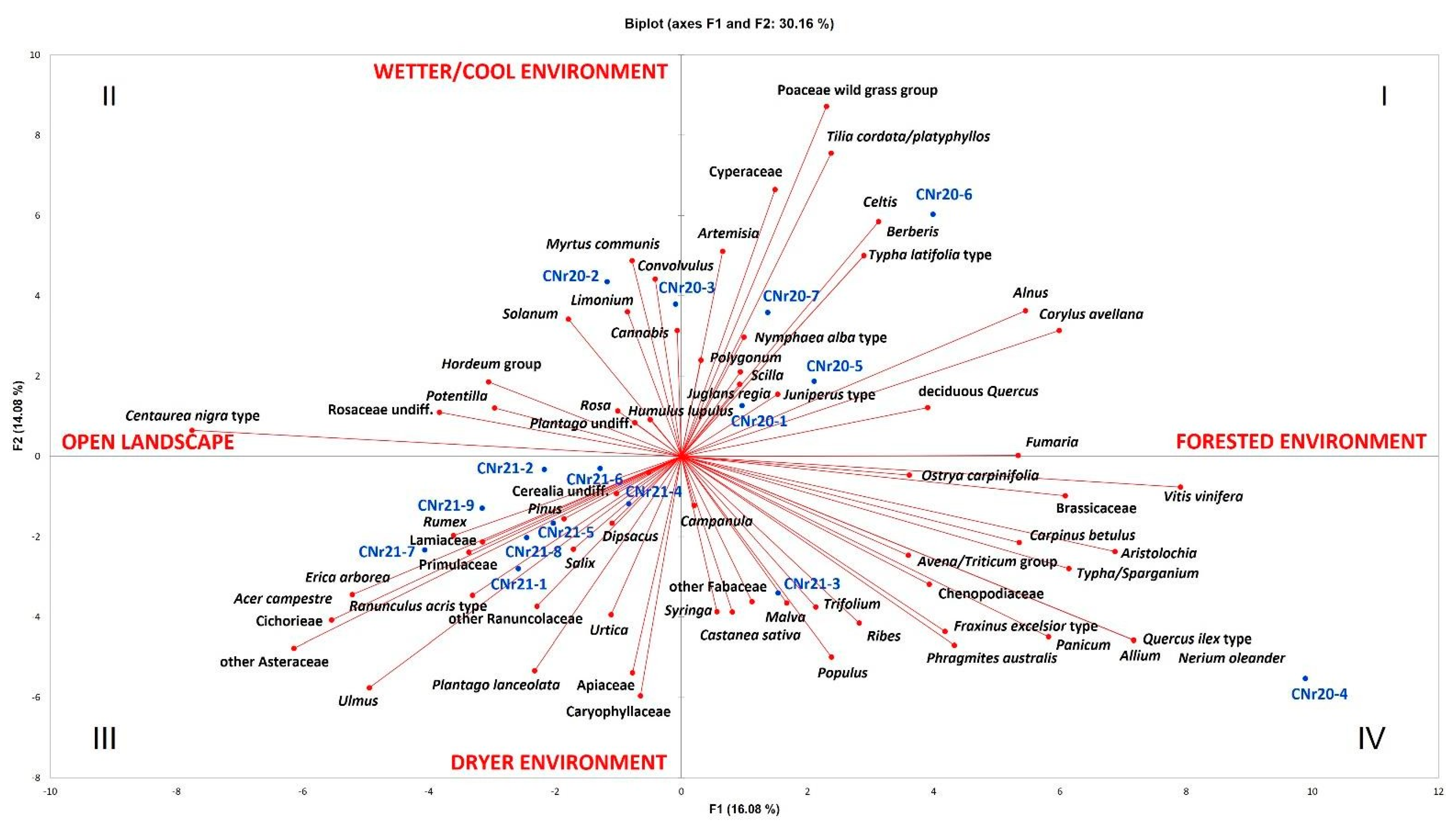
| Trench | Pollen Sample | Archaeological Label | Unit | Chronology (cal BC 2σ) | Description |
|---|---|---|---|---|---|
| 5 | CNr20-1 | 2 | 3 | Grey silt-sandy layer, not heavily anthropized, containing remains of material culture: pottery, flint, lumps of clay probably resulting from the breaking up of structural planes such as hearths, faunal remains, and charred plant macroremains | |
| CNr20-2 | 4 | 3 | |||
| CNr20-3 | 5 | 3 | 3957–3799 3941–3660 3765–3643 3651–3532 | ||
| CNr20-4 | 1 | 4 interf. 3 | Pre-site. Brown/yellowish loamy-clayey soil with limestone inclusions and charcoals. It is noticeably sloping, replicating the current slope of the forest. Possibly burned forest at the time of occupation. | ||
| CNr20-5 | 3 | 4 | Before SU 3 and 6 | ||
| CNr20-6 | 6 | 6 | Filling of US 5, consisting of loose soil with abundant rubble; it contains sparse cultural remains of flint, animal bones, and charred plant macroremains | ||
| CNr20-7 | 7 | 6 | 4318–4074 4246–4064 3955–3810 3891–3711 | ||
| 4 | CNr21-0 | Moss polster (current pollen rain) | |||
| CNr21-1 | 1 | 1 | SU 1 Dark brown clayey silt layer, strongly bioturbated, with slip material and secondary deposit | ||
| CNr21-2 CNr21-3 CNr21-4 CNr21-5 CNr21-6 | 4 5 6 7 8 | 4 5 6 7 8 | Copper Age | SU 4 Light grey silt-sandy layer extended throughout the area south of the bedrock SU 5 Calcareous clayey layer of grey colour with yellow streaks south of bedrock. SU 6 Dark brown sandy silt layer with white and yellow speckles and large-sized stones US 7 Layer of predominantly sandy matrix of grey colour with medium and small stones SU 8 Brown silty-sandy layer with charcoal and limestone intercalations | |
| CNr21-7 | 9 | 9 | Late Neolithic | SU 9 Yellowish-brown silty-clay layer Evidence of settlement with pottery and faunal remains | |
| CNr21-8 | 14 | 14 | Before Late Neolithic | Pre-site | |
| CNr21-9 | 17 | 17 |
| Trench | Macroremain Sample | Unit | Chronology (cal BC 2σ) | Litres of Sediment |
|---|---|---|---|---|
| 5 | 2 | 2 | - | 20 |
| 3 | 3 | 3957–3799 3941–3660 3765–3643 3651–3532 | 10 | |
| 6 | 6 | 4318–4074 4246–4064 3955–3810 3891–3711 | 10 |
Publisher’s Note: MDPI stays neutral with regard to jurisdictional claims in published maps and institutional affiliations. |
© 2022 by the authors. Licensee MDPI, Basel, Switzerland. This article is an open access article distributed under the terms and conditions of the Creative Commons Attribution (CC BY) license (https://creativecommons.org/licenses/by/4.0/).
Share and Cite
Tecchiati, U.; Salzani, P.; Gulino, F.; Proserpio, B.; Reggio, C.; Putzolu, C.; Rattighieri, E.; Clò, E.; Mercuri, A.M.; Florenzano, A. Palaeoenvironment, Settlement, and Land Use in the Late Neolithic—Bronze Age Site of Colombare di Negrar di Valpolicella (N Italy, On-Site). Quaternary 2022, 5, 50. https://doi.org/10.3390/quat5040050
Tecchiati U, Salzani P, Gulino F, Proserpio B, Reggio C, Putzolu C, Rattighieri E, Clò E, Mercuri AM, Florenzano A. Palaeoenvironment, Settlement, and Land Use in the Late Neolithic—Bronze Age Site of Colombare di Negrar di Valpolicella (N Italy, On-Site). Quaternary. 2022; 5(4):50. https://doi.org/10.3390/quat5040050
Chicago/Turabian StyleTecchiati, Umberto, Paola Salzani, Fiorenza Gulino, Barbara Proserpio, Chiara Reggio, Cristiano Putzolu, Eleonora Rattighieri, Eleonora Clò, Anna Maria Mercuri, and Assunta Florenzano. 2022. "Palaeoenvironment, Settlement, and Land Use in the Late Neolithic—Bronze Age Site of Colombare di Negrar di Valpolicella (N Italy, On-Site)" Quaternary 5, no. 4: 50. https://doi.org/10.3390/quat5040050
APA StyleTecchiati, U., Salzani, P., Gulino, F., Proserpio, B., Reggio, C., Putzolu, C., Rattighieri, E., Clò, E., Mercuri, A. M., & Florenzano, A. (2022). Palaeoenvironment, Settlement, and Land Use in the Late Neolithic—Bronze Age Site of Colombare di Negrar di Valpolicella (N Italy, On-Site). Quaternary, 5(4), 50. https://doi.org/10.3390/quat5040050









